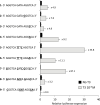Functional Definition of Thyroid Hormone Response Elements Based on a Synthetic STARR-seq Screen
- PMID: 35678380
- PMCID: PMC9249314
- DOI: 10.1210/endocr/bqac084
Functional Definition of Thyroid Hormone Response Elements Based on a Synthetic STARR-seq Screen
Abstract
When bound to thyroid hormone, the nuclear receptor TRα1 activates the transcription of a number of genes in many cell types. It mainly acts by binding DNA as a heterodimer with retinoid X receptors at specific response elements related to the DR4 consensus sequence. However, the number of DR4-like elements in the genome exceed by far the number of occupied sites, indicating that minor variations in nucleotides composition deeply influence the DNA-binding capacity and transactivation activity of TRα1. An improved protocol of synthetic self-transcribing active regulatory region sequencing was used to quantitatively assess the transcriptional activity of thousands of synthetic sites in parallel. This functional screen highlights a strong correlation between the affinity of the heterodimers for DNA and their capacity to mediate the thyroid hormone response.
Keywords: hormone response elements; nuclear receptors; thyroid hormone.
© The Author(s) 2022. Published by Oxford University Press on behalf of the Endocrine Society.
Figures



Similar articles
-
Half-site arrangement of hybrid glucocorticoid and thyroid hormone response elements specifies thyroid hormone receptor complex binding to DNA and transcriptional activity.J Biol Chem. 1994 Apr 29;269(17):12704-9. J Biol Chem. 1994. PMID: 8175681
-
Ligand-triggered stabilization of vitamin D receptor/retinoid X receptor heterodimer conformations on DR4-type response elements.J Mol Biol. 2000 Feb 25;296(3):743-56. doi: 10.1006/jmbi.2000.3499. J Mol Biol. 2000. PMID: 10677278
-
Transcriptional regulatory patterns of the myelin basic protein and malic enzyme genes by the thyroid hormone receptors alpha1 and beta1.J Biol Chem. 1998 Sep 11;273(37):24239-48. doi: 10.1074/jbc.273.37.24239. J Biol Chem. 1998. PMID: 9727048
-
Hetero- and homodimeric receptors in thyroid hormone and vitamin A action.Receptor. 1993 Fall;3(3):183-91. Receptor. 1993. PMID: 8167569 Review.
-
Ubiquitous receptor: structures, immunocytochemical localization, and modulation of gene activation by receptors for retinoic acids and thyroid hormones.Ann N Y Acad Sci. 1995 Jun 12;761:38-49. doi: 10.1111/j.1749-6632.1995.tb31367.x. Ann N Y Acad Sci. 1995. PMID: 7625741 Review. No abstract available.
Cited by
-
An Atlas of Thyroid Hormone Receptors' Target Genes in Mouse Tissues.Int J Mol Sci. 2022 Sep 28;23(19):11444. doi: 10.3390/ijms231911444. Int J Mol Sci. 2022. PMID: 36232747 Free PMC article.
-
Functions and Mechanism of Thyroid Hormone Receptor Action During Amphibian Development.Endocrinology. 2024 Sep 26;165(11):bqae137. doi: 10.1210/endocr/bqae137. Endocrinology. 2024. PMID: 39397558 Free PMC article. Review.
-
Thyroid hormone membrane receptor binding and transcriptional regulation in the sea urchin Strongylocentrotus purpuratus.Front Endocrinol (Lausanne). 2023 May 26;14:1195733. doi: 10.3389/fendo.2023.1195733. eCollection 2023. Front Endocrinol (Lausanne). 2023. PMID: 37305042 Free PMC article.
References
-
- Germain P, Staels B, Dacquet C, Spedding M, Laudet V. Overview of nomenclature of nuclear receptors. Pharmacol Rev. 2006;58:685-704. - PubMed
-
- Yen PM. Physiological and molecular basis of thyroid hormone action. Physiol Rev. 2001;81:1097-1142. - PubMed
-
- Perissi V, Rosenfeld MG. Controlling nuclear receptors: the circular logic of cofactor cycles. Nat Rev Mol Cell Biol. 2005;6: 542-554. - PubMed
-
- Judelson C, Privalsky ML. DNA recognition by normal and oncogenic thyroid hormone receptors. Unexpected diversity in half-site specificity controlled by non-zinc-finger determinants. J Biol Chem. 1996;271:10800-10805. - PubMed
Publication types
MeSH terms
Substances
Associated data
LinkOut - more resources
Full Text Sources
Molecular Biology Databases

